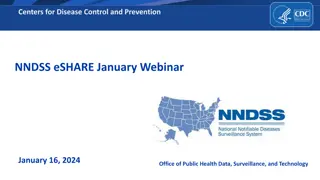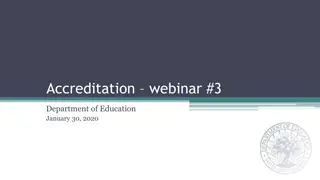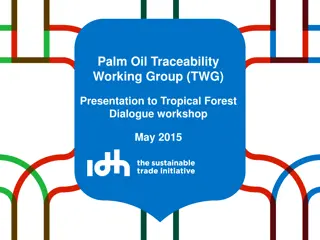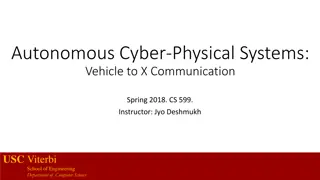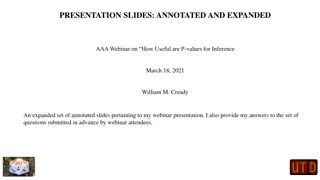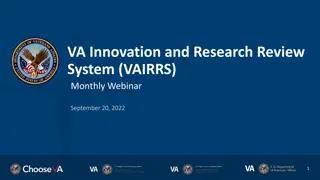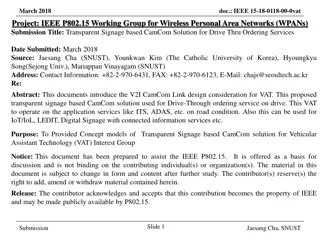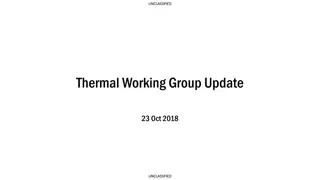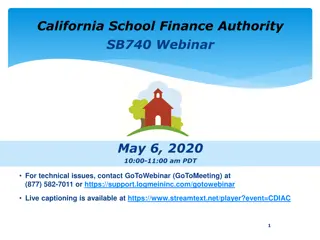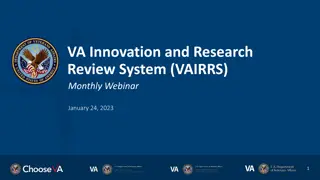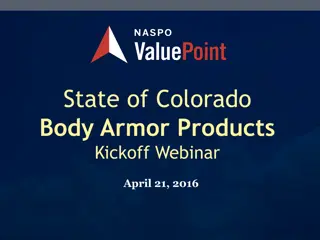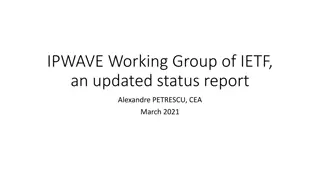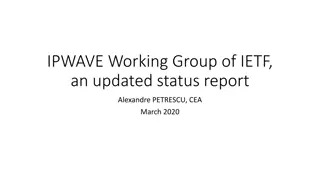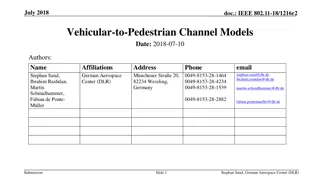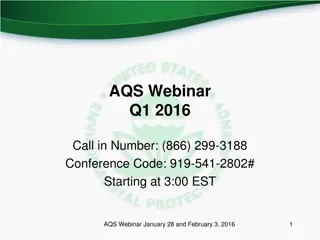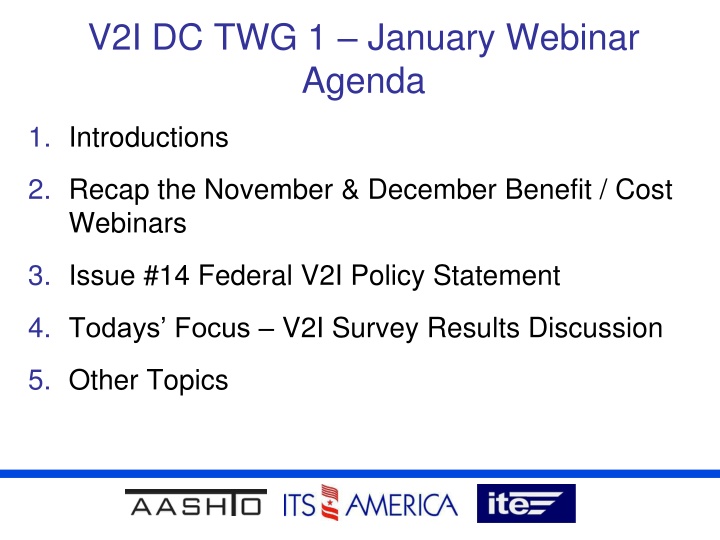
January Webinar Agenda: V2I Deployment and Collaboration
Explore the January webinar agenda which includes introductions, a recap of past benefit/cost webinars, discussions on a Federal V2I policy statement, and the presentation of V2I survey results. Collaboration between V2I Deployment Coalition TWG 1 and TWG 4 on Federal V2I policy is a key focus. Potential topic areas include the need for V2I deployment, legislative language samples, aftermarket device roles, liability implications, data protection, and more.
Download Presentation

Please find below an Image/Link to download the presentation.
The content on the website is provided AS IS for your information and personal use only. It may not be sold, licensed, or shared on other websites without obtaining consent from the author. If you encounter any issues during the download, it is possible that the publisher has removed the file from their server.
You are allowed to download the files provided on this website for personal or commercial use, subject to the condition that they are used lawfully. All files are the property of their respective owners.
The content on the website is provided AS IS for your information and personal use only. It may not be sold, licensed, or shared on other websites without obtaining consent from the author.
E N D
Presentation Transcript
V2I DC TWG 1 January Webinar Agenda 1. Introductions 2. Recap the November & December Benefit / Cost Webinars 3. Issue #14 Federal V2I Policy Statement 4. Todays Focus V2I Survey Results Discussion 5. Other Topics
Benefit / Cost Webinars Recap November Webinar Desk Reference and Tools for Estimating the Local, Regional and State-wide Economic Development Benefits of Connected Vehicle Infrastructure Deployments AASHTO Near TermV2I Transition and Phasing Analysis Connected Vehicle Life Cycle Cost Model (LCCM) December Webinar Summary Document circulated with the TWG 1 meeting agenda Includes links to view each webinar recording 2 2
Agenda Item #2: V2I Deployment Coalition TWG 1 & TWG 4 Collaboration on: Issue #14: Federal V2I Policy Statement
Background At the June meeting in Pittsburgh: TWG 1 members identified a need for a Federal V2I Policy Statement. A new Issue (#14) was added to the issues 4
Background Issue #14: The recent NHTSA resolution regarding vehicle-to-vehicle communications has helped the V2V industry. Similar strong encouragement from a federal agency to give infrastructure owners and operators a push to deploy V2I would also help V2I. It is recognized that a rulemaking is likely not possible, but perhaps another strong encouragement from a federal agency (e.g. something similar to an Every Day Counts EDC model) could be released. The V2I industry needs a strong message from a federal agency encouraging V2I deployment. 5
Background In January, core members of TWG 1 and TWG 4 met by webinar to discuss collaboration between TWGs The idea: Involve members from both TWGs in discussions, and collaborate together Any request to USDOT could come from TWG 4, similar to feedback offered on guidelines 6
Potential Topic Areas identified by TWGs 1 & 4 Explanation of why agencies should deploy V2I Sample legislative language for agency consideration Clarification of aftermarket device role in V2I deployment Requirements for deploying, operating and maintaining V2I equipment Statement on potential liability implications Direction on how data should be protected by vendors and agencies Explanation of how USDOT is protecting DSRC band for V2I Recommendations on use of DSRC band and related channels within the band for V2I 7 7
Potential Topic Areas identified by TWGs 1 & 4 Update: TWG 4 shared this concept on their January 21 TWG webinar USDOT representatives on the TWG shared that many (perhaps all) of the topics would be addressed by the V2I Deployment Guidance and Supporting Products to be released in Quarter 1 of 2016 Suggestion is that TWG 1 & 4 not prepare any requests until the Deployment Guidance documents are released 8 8
V2I Policy Statement Discussion / Feedback from the members? 9 9
Agenda Item #3: Vehicle to Infrastructure Deployment Coalition (V2I DC) & AASHTO CAV TWG Connected Vehicle Applications Survey PRELIMINARY Survey Results January 28, 2016
Background Survey questions were crafted by TWG 1 members AASHTO CAV TWG suggested one question (Question 9) that they had been planning to ask DOTs 11 11
Preliminary Results 25 responses to the on-line survey Some partially responded 2 phone calls instead of on-line survey responses 12 12
Question 1: Please indicate the agency you are representing
Q1: Respondents 25 responses Virginia DOT Wisconsin DOT Metropolitan Transportation Commission (MTC) Carnegie Mellon University Traffic21 Institute Minnesota DOT Michigan DOT California DOT California PATH/UC Berkeley VTTI THEA Connected Vehicle Pilot Deployment Arizona DOT, TSMO Division Pennsylvania DOT Utah DOT King Count Metro Transit City of Palo Alto Oregon DOT NYSDOT City of Chattanooga, TN NYCDOT The Ohio State University of Mobility Research and Business Development Louisiana DOTD Prospect Silicon Valley City of Alexandria, VA City of Walnut Creek Santa Clara County Road and Airports Department Washington State DOT 14
Question 2: If you would like to discuss the responses to these questions by phone, instead of completing the survey, please provide a convenient way to contact you and we will do so. Two Agencies opted to participate in phone conversations One (a local agency) explained their primary short-term emphasis for Connected Vehicles would likely be traffic signal control The other had multiple comments, see the following slide:
Phone Feedback State DOT Success will be a measure of the penetration and the acceptance of the roadside deployments and vehicle applications Safety is their highest priority, but it needs to go beyond just delivering warnings to the vehicle to also interacting with the V2V control aspects Traffic Signals are low on their list because it requires most or all vehicles to be equipped to recognize the most value 16
Phone Feedback State DOT Described 3 levels of safety applications: 1. Static alerts of threats to drivers (e.g. 30 MPH warning on curves) 2. Monitor vehicle performance, and warn if needed (e.g. display 30 MPH if vehicles going above XX speed) 3. Potential Automation (external alert sent from the roadside work with on-board controls to adjust vehicle speed and with V2V to warn other vehicles) 17
Question 3: Please identify the Connected Vehicle applications that are included in your agency s plan or proposal for Connected Vehicle deployment, or that you have already deployed. Please also indicate which 5 applications you feel are the most beneficial to deploy.
Background on Q3 Question 3 attempted to learn 3 things: Which CV applications responding agencies had included in their proposal or plan for CV deployment Which CV applications responding agencies felt were most beneficial; and Which CV applications responding agencies had already deployed 19 19
Background on Q3 Related to Question 3: TWG 1 members decided to provide a set of Connected Vehicle applications and ask survey responders to select from the list TWG 1 members agreed to use the CVRIA list of Applications 72 V2I applications from the CVRIA were included Excluded V2V, Core Services, Included Signal Phase and Timing (Support Application) Grouping of applications was based on the CVRIA groupings 20
Q3: V2I Applications 72 V2I Applications from CVRIA Website (presented in 8 categories) Category AERIS/Sustainable Travel Border, Commercial Vehicle, Freight Traffic Network/Traffic Signals Traveler Information Road Weather Public Safety Transit V2I Safety Number of V2I Applications 16 8 9 3 6 5 12 13 21
CV Applications Included in Plans or Proposals Q3 Q3: CV Applications Included in Agencies Plans or Proposals for Deployment : CV Applications Included in Agencies Plans or Proposals for Deployment (# of Responders = (# of Responders = 21) 21) 20 18 16 14 12 10 8 6 4 2 0 V2I Safety AERIS / Sustainable Travel Border, Commercial Traffic Network/ Traffic Signals Transit Road Weather Vehicle, Freight Public Safety Traveler Information 22 22
CV Applications Included in Plans or Proposals 11 Most Selected Applications Question 3: CV Applications Included in Agencies Plans or Proposals for Deployment Question 3: CV Applications Included in Agencies Plans or Proposals for Deployment (Top 11 Applications Selected; # of Responders = 21) (Top 11 Applications Selected; # of Responders = 21) Road Weather 18 17 16 14 12 12 11 11 11 10 10 10 9 9 9 9 8 6 4 2 0 Emergency Vehicle Warnings about Upcoming Alerts for Drivers and Workers Intelligent Traffic Signal Speed Harmonization Queue Warning Road Weather Motorist Alert Signal Phase and Timing Curve Speed Warning Vehicle Data for Traffic Warnings about Hazards in a Incident Scene Work Zone Preemption Operations Work Zone and Warning System Work Zone 23
4 Focus Areas of the V2I DC At the September, 2015 V2I DC Executive Committee meeting, four focus areas were defined for the V2I DC Focus Areas Defined by V2I DC 1. Intersections 2. Queue Warnings 3. Work Zone Management 4. Curve Warnings 24 24
How do the most selected Applications map to the focus areas? Question 3: CV Applications Included in Agencies Plans or Proposals for Deployment Question 3: CV Applications Included in Agencies Plans or Proposals for Deployment (Top 11 Applications Selected; # of Responders = 21) (Top 11 Applications Selected; # of Responders = 21) All Four Focus Areas Represented! 1. 2. 3. 4. Intersections Queue Warnings Work Zone Management Curve Warnings 18 17 16 Traffic Network/Traffic Signals 14 12 12 11 11 11 10 10 10 9 9 9 9 8 6 4 2 0 Warnings about Upcoming Alerts for Drivers and Workers Emergency Vehicle Intelligent Traffic Signal Queue Warning Speed Harmonization Road Weather Motorist Alert Signal Phase and Timing Curve Speed Warning Vehicle Data for Traffic Warnings about Hazards in a Incident Scene Work Zone Preemption Operations Work Zone and Warning System Work Zone 25
CV Applications Responders Feel Would Be Most Beneficial to Deploy Q3: Select the 5 Applications You Feel Would Be Most Beneficial to Deploy (# of Responders=21) 10 9 8 7 6 5 4 3 2 1 0 Traveler Information AERIS / Sustainable Travel Transit V2I Safety Vehicle, Freight Road Weather Traffic Network/ Public Safety Traffic Signals Commercial Border, 26
CV Applications Most Beneficial to Deploy 11 Most Selected Applications Question 3: Select the 5 Applcations You Feel Would be Most Beneficial to Deploy Question 3: Select the 5 Applcations You Feel Would be Most Beneficial to Deploy (Top 11 Applications; # of Responders = 21) (Top 11 Applications; # of Responders = 21) 10 9 9 8 8 8 7 7 7 6 6 5 4 4 4 4 4 4 3 2 1 0 Signal Phase and Road Weather Motorist Transit Signal Priority In-Vehicle Signage Upcoming Work Zone Pedestrian in Signalized Intelligent Traffic Signal Queue Warning Information Systems Red Light Violation Vehicle Data for Traffic Advanced Traveler Crosswalk Warning Alert and Warning Warnings about Warning Timing Operations System 27
How do the Applications selected as most beneficial map to the focus areas? Question 3: Select the 5 Applcations You Feel Would be Most Beneficial to Deploy Question 3: Select the 5 Applcations You Feel Would be Most Beneficial to Deploy (Top 11 Applications; # of Responders = 21) (Top 11 Applications; # of Responders = 21) 3 of 4 Focus Areas Represented Intersections Queue Warnings Work Zone Management Curve Warnings 1. 2. 3. 10 9 9 8 8 8 7 7 4. 7 6 6 5 4 4 4 4 4 4 3 2 1 0 Intelligent Traffic Signal Road Weather Motorist Transit Signal Priority In-Vehicle Signage Signal Phase and Upcoming Work Zone Red Light Violation Pedestrian in Signalized Queue Warning Information Systems Vehicle Data for Traffic Advanced Traveler Crosswalk Warning Alert and Warning Warnings about Warning Timing Operations System 28
Comparing the Most Selected Planned/Proposed Applications vs the Most Beneficial Only in Planned or Proposed Applications Only in Top 5 Responders Feel are Most Beneficial Overlap in Both 1. Incident Scene Work Zone Alerts for Drivers and Workers Speed Harmonization Emergency Vehicle Preemption Curve Speed Warning Warnings about Hazards in a Work Zone 1. Road Weather Motorist Alert & Warning 2. Queue Warning 3. Vehicle Data for Traffic Operations 4. Intelligent Traffic Signal System 5. Signal Phase & Timing 6. Warnings About Upcoming Work Zones 1. 2. Transit Signal Priority Advanced Traveler Information Systems Red Light Violation Warning In-vehicle Signage Pedestrian in Signalized Crosswalk Warning 2. 3. 3. 4. 5. 4. 5. 29
CV Applications Already Deployed by Responding Agencies Question 3: CV Applications Already Deployed by Agencies Question 3: CV Applications Already Deployed by Agencies (Applications with 2 or more agencies; # of Responders = 22) (Applications with 2 or more agencies; # of Responders = 22) Transit Traveler Information Border, Commercial Vehicle, Freight AERIS Sustainable Travel Road Weather Traffic Network/ Traffic Signals Public Safety 4.5 4 3.5 3 2.5 2 1.5 1 0.5 0 Signal Phase and Timing Roadside Lighting Performance Monitoring and Transit Signal Priority Electric Charging Stations Electronic Toll Collection Advanced Traveler Information Road Weather Information for Emergency Vehicle Preemption Enhanced Maintenance Decision Eco-Approach and Departure at Maintenance and Fleet Management Systems Signalized Intersections Management Support System Planning Systems
CV Applications Already Deployed Mapped to the V2I DC Focus Areas Question 3: CV Applications Already Deployed by Agencies Question 3: CV Applications Already Deployed by Agencies (Applications with 2 or more agencies; # of Responders = 22) (Applications with 2 or more agencies; # of Responders = 22) Transit Traveler Information Border, Commercial Vehicle, Freight AERIS Sustainable Travel Road Weather Traffic Network/ Traffic Signals Public Safety 4.5 1 of 4 Focus Areas Represented! 4 1. 2. 3. 4. Intersections Queue Warnings Work Zone Management Curve Warnings 3.5 3 2.5 2 1.5 1 0.5 0 Performance Monitoring and Signal Phase and Timing Roadside Lighting Transit Signal Priority Electric Charging Stations Electronic Toll Collection Road Weather Information for Emergency Vehicle Preemption Advanced Traveler Information Enhanced Maintenance Decision Eco-Approach and Departure at Maintenance and Fleet Management Systems Signalized Intersections Management Support System Planning Systems
Question 4: If there were additional applications that you seriously considered, but decided not to include in your proposed or planned deployment, please list those, together with an explanation of why you decided not to include the application(s). 10 responses received
Q4: Additional applications not included in deployment plans Transit Applications that require a high saturation of DSRC enable vehicles T-Connect Safety applications Bicycle share stations and car share stations Commercial vehicles Intersection collision warning systems Monitoring vehicle traffic control for snow removal operations and incident/crash detection 33
Question 5: What are the problems you are solving by deploying these applications? 15 responses received
Q5: Problems solved by deploying applications Response time Travel time of transit buses and trucks Mobility of general travelers Safety in congested corridors Safety of roadside works and first responders Safety at intersections Improve air quality 35
Question 6: What communication technology approaches are included in your plan/proposal? 17 responses received
Q6: Communication Technology Approaches Existing backhaul communications DSRC Cellular Internet WiFi GPS Fiber 37
Question 7: If DSRC is a communication approach identified in #6 above, please provide the DSRC messages you used/plan to use for your DSRC communications? 14 responses received
Q7: DSRC Messages BSM Any/all of the J 2735 (2015) Messages SPAT MapData Probe Data Management (PDM) Snow plow signal request Road weather info Basic Infrastructure Message will be important so we need to define that 39
Question 8: If you have identified any current infrastructure processes (e.g. environmental reviews, MUTCD compliance, etc.) or other challenges (lack of backhaul, technical capability, lack of developed applications, security concerns, etc.) which will prevent or hinder your deployment of the Connected Vehicle infrastructure, please list those with a brief explanation. 15 responses received Note: This question relates to Issue #13 Infrastructure Processes as V2I Obstacles Added by TWG 1
Q8: Infrastructure Processes that will prevent or hinder deployment DSRC Security Existing Patents IT security lack of guidance Combining 2 or more CV apps into a single app Lack of application readiness / developed applications Lack of documentation of application details Lack of supporting research Uncertain timing around NHTSA rule making & anticipated rollout of vehicles with DSRC Simple Terminology (CV vs. AV; V2I vs. V2V vs. V2X) Backhaul (the lack of) Cities have different set of operating philosophies than State DOTs 41
Question 9: As you have worked toward deployment (planning, pilot proposal preparation, early deployment experience, etc.), what are the two most important or surprising things you have discovered that you think would be useful for others to be aware of? 12 responses received
Q9: Most Important or Surprising Comments are Grouped into 5 Categories & Highlights are Summarized in this Presentation (All responses will be in the written report) Categories include: 1. Technology Related Comments 2. Current Challenges 3. Rate of Change 4. Coordination / Communication 5. Deployment Decisions 43
Q9: Most Important or Surprising Sample Comments: Technology DSRC works well in a hot climate and the range is greater than expected. Some of the pieces are far from being ready for real deployment; there are very few developed applications. Installation of connected vehicle infrastructure is not a "cookie cutter" process; each individual site has its own nuances .. It takes time for applications to mature to full deployment. 44
Q9: Most Important or Surprising Sample Comments: Current Challenges Many, especially local agencies, do not have the bandwidth to keep up, which is creating a large disconnect between federal initiatives, private industry, and local owners / operators. OEM's are promoting vehicles with on-board technology, but not indicating the connection between vehicles and infrastructure Despite some information on costs and benefits, right now it is very hard to confidently quantify them . 45
Q9: Most Important or Surprising Sample Comments: Rate of Change The rapid development of automated vehicle technology and the projection of these vehicles operating on roadways in the near future. It is incredible how quickly the field is advancing right now. 46
Q9: Most Important or Surprising Sample Comments: Coordination/ Communication Having a good relationship between IT and Operations is key. There is a lack of common vision between local agencies and State DOT's. That gap needs to be closed. It is difficult at this point to gain tremendous public input on this process. I feel it is a lack of understanding. Successful CV will be highly dependent on partnerships across many modes to fully leverage regional benefits. 47
Q9: Most Important or Surprising Sample Comments: Deployment Decisions Listening to the conversations of other submitting agencies, there appears to be a 'pick-and-choose' approach to application lists, rather than concentrating on transitioning existing job functions/responsibilities to new infrastructure Transit agencies are very interested in deploying CV to improve transit operations. Deploying CV at this point is risky. Agency access to private vehicle CV data is still undefined 48
Next Steps with the Survey Sharing Survey Results Written Report summarizing findings and including all the text/data received from survey responders Sometime in February Discussion for the TWG: Should we schedule additional webinars/calls for a subgroup of the TWG to discuss the findings? Should we consider formal outreach of the findings? (e.g. NoCOE webinar) 49
Next Steps for TWG 1 Next Webinar: February 25, 2016 Proposed Topics: 1. Issue #13: Infrastructure Processes as V2I Obstacles (Question 8 in the Survey) Open discussion about next steps / additional actions needed Full responses to Question 8 will be circulated before the next webinar 2. Issue #14: Follow-up Discussion on Federal V2I Policy Statement 50 50

